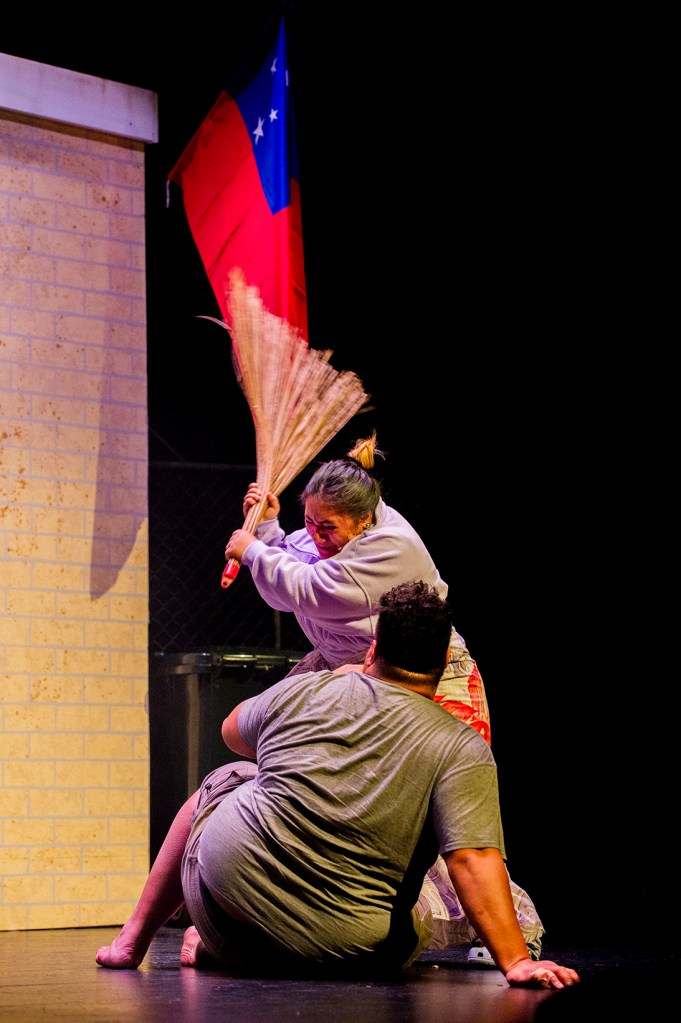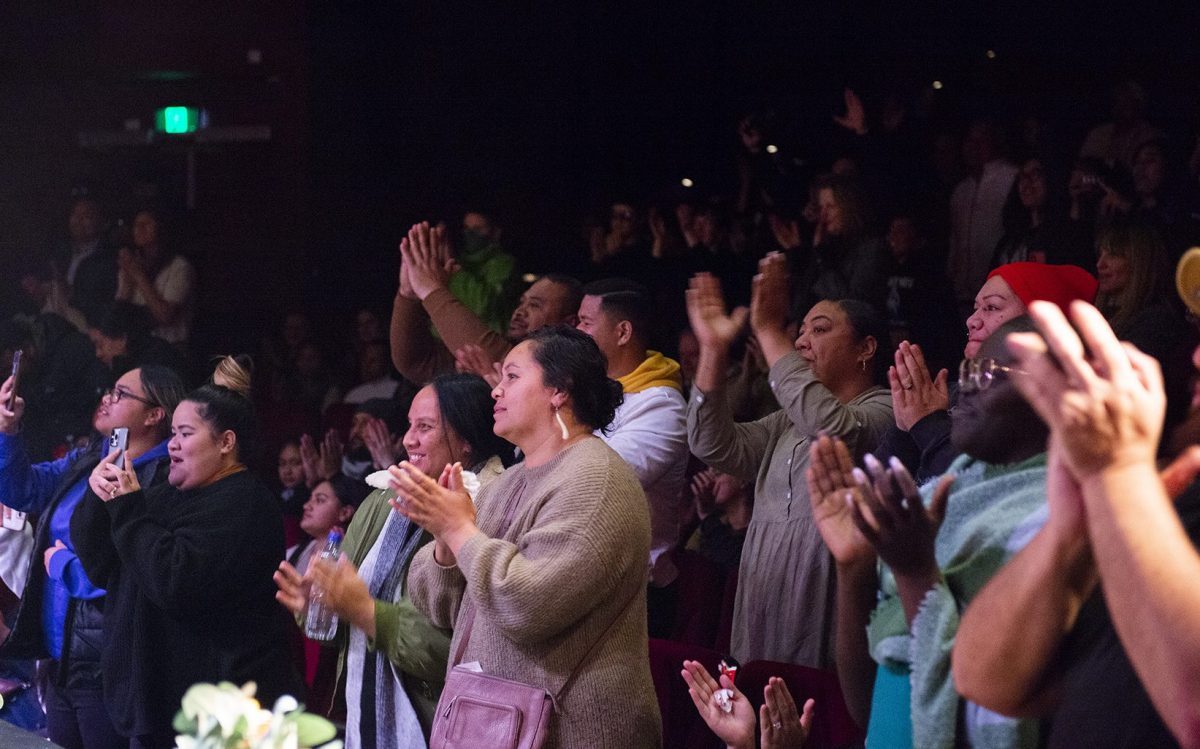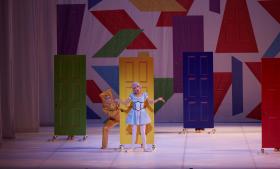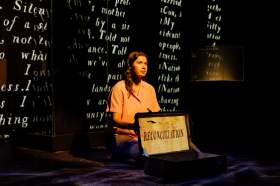In 2020, a 15-year-old Tongan boy named Solomone Taufeulungaki was stabbed to death in a violent brawl among a group of youths aged 13 to 16 at the Brimbank Shopping Centre in Deer Park, Melbourne.
The death of the young boy shocked the Pacific Islander community around Australia, and families began fearing for their young ones in the weeks that followed.
Around the same time, Western Edge artists Michael Logo, Chanella Macri and Rexson Pelman were starting to work on the second iteration of their play Lele, Butterfly and knew they needed to speak on what was occurring around them.
Spot the difference
Lele (2023) is a fictional story that follows the lives of a Samoan Australian family trying to walk the fine line between living in the Western world and remaining rooted in Samoan culture and traditions.
The play was originally created in 2018 as an adaptation of the Greek play Antigone by Sophocles and has since undergone two reiterations, with its most recent being performed at the Wyndham Cultural Centre late last month.
Although the performance touched on a number of different themes relevant to Samoan Australian families, a major one stood out – the importance of community.
Throughout the play the creators referenced the huge drill music wave that has overtaken Australia, especially the Pacific Islander population, in recent years.
Pelman knew Taufeulungaki personally and, after the youth’s tragic death, he decided to include this aspect of drill music into the performance.
Co-Creator Macri tells ArtsHub: ‘I remember Rex just saying really plain and simple, “If we’re going to do this, I want to look at drill because of what happened with the young man, and I want to look at how this is affecting our youth”.’
Although the genre of drill has roots in the US and is hugely popular in the UK, it had never been a major genre within Australia until drill group ONEFOUR from Mount Druitt, Sydney exploded onto the scene in 2019 with their song ‘The Message’.
The group rose to fame unbelievably quickly, but were especially popular in the Pacific Islander community as group members were all ethnically Samoan.
However, with the rise of drill music around Australia – especially in Sydney and Melbourne – young Pacific Islanders were starting to associate themselves with the gang activity and violence portrayed through ONEFOUR’s music videos and lyrics.
Macri recalls when she first heard ONEFOUR’s music and says it moved her to tears, both out of fear for what it could mean and also out of pride that they were speaking on the truth of how some live in order to make ends meet.
‘I remember listening to it in my driveway and I just started uncontrollably sobbing, because it was so real and the glorification of it was so high that I was so afraid for what it would mean for young Pasifika boys in terms of being in the world,’ she says.
‘I was so proud and so scared at the same time because I remember just thinking, “Tell them, tell them what’s happening, tell them what our people have to do to get money to feed their families, to be successful here because we can’t be successful anywhere”.’
Macri continues: ‘But I was also thinking, this is going to hit so many young people who are not receiving it in that way… So many of our young ones are so lost, they’re searching for family and community and I was like, “God, they’re going to see this and it’s what they’re going to attach to”.’

The feeling of disconnection from culture and community is one that many Samoan Australian and Pacific Islander youth throughout the diaspora know all too well. Through the exploration of drill music in Lele, the creators portrayed the very real struggle Samoan Australian youths have in trying to find their place in the world and how hard it can be for youths in that situation to spot the difference between a community and a gang.
Macri adds: ‘Although it completely predates Lele, I remember Michael the other co-creator said something one time that just stays firmly planted in my heart and is so relevant.
‘He said our people are such family people and community people that when we come [to Australia] we don’t have that same connection and that’s why boys either get into sports, or go to church or get into gangs, because that’s where you find that brotherhood, that masculinity, that community – something just feels like it’s missing over here, because you feel so alone.
‘It was a massive question for us when we were looking at those relationships between the brothers, the cousins and that instrumental one to the father [in the show], and asking “Who do you become? How do you become a man here? And what do you model that off when there isn’t anything to see?”’
Out of sight
Grace Vanilau, a Community Arts and Cultural Development practitioner and multidisciplinary artist, attended one of the first community readings of Lele in 2019 and has been a consistent supporter of the work since.
When she watched the second iteration of Lele in 2021, the story hit close to home and sent her through a whirlwind of emotions. ‘It was really confronting, really triggering… It was like watching through a window and I just cried and cried,’ Vanilau tells ArtsHub.
‘There were so many moments throughout the show where I felt like I was witnessing elements of my own upbringing and those of my extended family members – the love, the violence, the chaos.
‘I actually thought, “Finally a story that is brave enough to shine light on some of the very real challenges our communities are facing living in diaspora, in a system that was never designed for us to benefit from”.’
Vanilau has been a part of the arts industry for over 30 years, ever since she was 17, and has been using art to create change in Samoan and Pacific Islander communities, especially for youths.
For Vanilau, stories like Lele need to be told, regardless of how heavy and confronting they are, to ensure people are aware that Pacific Islander communities are multifaceted and face a range of different issues that many aren’t privy to.
‘I think it is important our community understands that the story may not be comfortable to watch … but I strongly believe that if you even reach one person or a handful of people and you elevate them for a moment to think about the things they need to reflect on, and to heal and to look at, then I feel we’ve done our work,’ Vanilau says.
‘There are so many aspects to us and we need to break that mould to get people to see us in our fullness, and also see us in our brokenness because that’s what their system has created – this system was never designed for us, especially here in Australia,’ Vanilau continues.
‘We need ongoing cultural specific programs that our young people and communities can see themselves reflected in and, in turn, begin to raise their voices and speak truth to power. There is a need for strength-based frameworks that provide culturally safe spaces, rather than the deficit models and approaches that many mainstream institutions provide.’
The message
Lele was raw, heartbreaking and confronting, but it was also powerful beyond measure. It was one of few truthful portrayals of the Samoan Australian experience, created by the Samoan community, for the Samoan community.
The creators not only effortlessly weaved together multiple realities of what being a Samoan in the diaspora is like, but the story also acted as a reminder that there is power in community.
It evoked questions of what needs to change within the Samoan Australian community and of how they can bring about that change in order to save the youth and captain their narratives.
Macri says: ‘Lele was never meant to be a statement, so much as it was meant to be an offering – to ask our friends and our family and our community to come and talk about some of these things.’
If the closing night of Lele at Wyndham Culture Centre was anything to go by, the performance achieved this very aim, as people gathered in excited clusters, speaking of the show they had just experienced.
Nothing else speaks to the very core of what Lele is about than the play’s closing dialogue delivered by the mother. The actress held the audience in a deep trance as she delivered her final words: ‘We close our eyes and we refuse to see. Deny that our children are killing each other. That God isn’t reaching them. That there is so much sadness and shame in their hearts they take their own lives. And still we can’t hear. The children of Samoa cry out across Australia, across the Pacific, across the globe.
‘So, let’s not let them fall. Let us be what holds them, what lifts them, what guides them.’
Lele was performed from 22-23 June at Wyndham Cultural Centre.
This article is published under the Amplify Collective, an initiative supported by The Walkley Foundation and made possible through funding from the Meta Australian News Fund.





